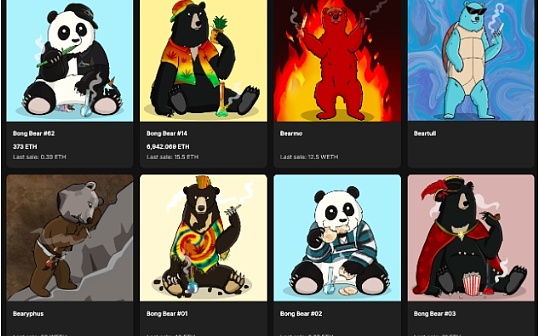
Author: Jay & Suyu, Four Pillars; Translation: Bitchain Vision xiaozou
1. Preface
The development level of Internet infrastructure is closely related to the emergence of various applications.In the early stages of the Internet, bandwidth was limited and network communication standards were very inefficient, resulting in longer loading time for web pages and low accessibility for multimedia content by users.In this environment, development focusing on simple web applications and text-based information exchange dominates.
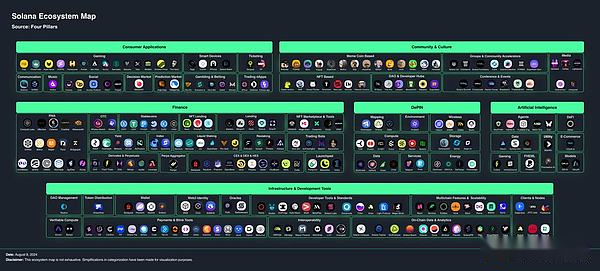
However, with the emergence of broadband Internet and the advancement of data network standard technology, the Internet’s data processing efficiency has been greatly improved.This makes it possible to implement applications that can handle large amounts of data and have multiple functions, with various high bandwidth applications emerging, such as video streaming platforms such as Netflix, online games, large file sharing, real-time communications and collaboration tools.In other words, the development of Internet infrastructure has promoted the development of new applications and services, and has fundamentally changed people’s way of consuming digital content.
We seem to see this momentum again in Solana – in the past four years since the launch of the Autonomous Network, Solana has rapidly grown into an ecosystem with over 700 decentralized applications.This is thanks to its steadily optimizing network throughput and consumer/developer-friendly capabilities while gradually improving moderate decentralization.Therefore, the Solana ecosystem is not only huge, but also provides a relatively leading utility than other ecosystems.
In this article on the Solana ecosystem, our goal is to form an overview of the rapidly growing Solana ecosystem by categorizing and planning over 250 of the most active projects, from infrastructure layer to consumer applications..
*Ecosystem projects are divided into six categories: “Infrastructure and Development Tools”, “Financial”, “Decentralized Physical Infrastructure Network (DePIN), “Artificial Intelligence (AI), “Consumer Applications” and “Community and Culture”.
2. Infrastructure and development tools

As mentioned in a previous report on Solana Mega, the most important factor affecting the performance and collaboration of applications throughout the Solana ecosystem (priority to composability) is the various infrastructure technologies developed at the protocol level.In addition to the SVM technology stack for transaction processing, Solana’s rich toolkits, libraries and standard sets support the development of various applications through more efficient and efficient utilization of the Solana platform.
Notable examples are: Solana Program Library, a library of various functions, such as token creation and management (SPL token program), token exchange and lending protocols; Anchor Framework, which is the most popular developmentFrameworks, especially favored by new developers at Solana or those who want to quickly build and deploy applications; GameShift, a framework designed to simplify the process of creating blockchain games.In addition, standard sets such as Token Extension and Compression technology eliminate the problem of inefficiency in communication, allowing applications that need to process large amounts of data or implement complex logic.

Payment-related API modules are particularly noteworthy in terms of availability, which are JavaScript libraries that simplify cryptocurrency payments, and Blinks (Blockchain + Links) solution that defines on-chain transactions in the form of URLs, allowing them to be in variousIntegrate and use in applications.
In addition, in terms of network stability, in addition to Solana Labs and Jito Labs clients, client diversity projects such as Firedancer, Tinydancer and Agave are also in progress.In addition, many projects are working to flexibly utilize SVM execution environments in multi-chain environments through SPE (Solana Permissioned Environments) or various protocols, allowing a single product to build its own ecosystem or improve the efficiency of existing ecosystems.
Below is a list of some projects in the field of “Infrastructure and Development Tools”. If you want to understand the future development of the Solana ecosystem, these projects deserve close attention.
(1) Backpack
Coral, a development company for Anchor development framework, created Backpack Wallet and Mad Lads, both iconic representatives of scalable technologies and the benign community of Solana’s ecologically benign.Both products are deployed as xNFT, literally understood as a “executable” standard plugin for Web3 application assets.
The Backpack wallet was launched to allow users to experience various dApps deployed as xNFT in an integrated environment.It currently provides a seamless user experience for xNFT versions of approximately 90 applications that span a variety of fields including gaming, NFT and DeFi.
(2) Squads
Squads is a custodial layer solution that enables safer asset management and operations, providing standards for a variety of smart accounts, including asset management, permission settings and multi-signature accounts.
The Squads Labs team launched the first smart wallet, Fuse Wallet (iOS beta) within the Solana ecosystem.Fuse Wallet provides 2FA, spending limit, social recovery, time lock, key rotation, gas abstraction and native staking.
In addition, the Squad team has announced the launch of the Squad Policy Network (SPN), which enables enterprises to manage centralized hosting in a trustless decentralized way.After SPN is integrated with Jito (re)staking, it will provide customized policies and common policies for all users.
(3) Code
Code SDK is an open payment protocol and application that allows developers to easily receive small payments from users around the world – anyone can charge users a small fee in a network environment through the “Pay with Code” button, which users need5 cents, while developers need a fixed fee of 1 cent to cover blockchain transaction costs.
(4) Sphere
Sphere is a settlement project that won the Solana Summer Camp Hacking Thread last December.Sphere has various features including crypto outages/deposits, on-chain subscriptions, invoices, payment links, anti-money laundering/anti-fraud and reporting.
(5) TipLink
TipLink is a lightweight unmanaged wallet that allows you to easily transfer digital assets through links or QR codes.In other words, users can create a wallet immediately by simply linking their Gmail account or Solana wallet to the received link or QR code and can use the assets received through the link wallet.
(6) Dialect
Dialet provides a development stack for the decentralized messaging protocol deployed on the Solana network.Recently, they developed the “Actions” protocol, which defines a series of on-chain transactions in the form of a URL, as well as the “Blinks” client, which detects these Actions protocols and allows them to be linked and used in various applications.
In other words, developers can use the Actions protocol to create URL links for on-chain tasks in target applications, and end users can seamlessly perform various on-chain activities (e.g. voting, prediction, subscription, donation) by interacting with these links., mining, token exchange, etc.).
Various Blinks-related projects are also emerging, such as Blnk.fun, which can easily create and trade Blinks without coding, and Send, which is a community-based platform that explores various application use cases of Blinks and activates the ecosystem..
(7) Wormhole
Wormhole is a multi-chain bridge protocol launched by Solana and Certus One in collaboration to transfer messages and assets between multiple blockchains, including Solana.It is particularly important to note that Wormhole’s packaging assets are the most liquid assets on Solana. Wormhole’s main goal is to overcome the liquidity fragmentation problem in the blockchain ecosystem and establish an integrated environment where assets and information flow freely across the network..
To this end, Wormhole adopts the native token transfer (NTT) framework, which uses the burn-and-mint mechanism and Circle’s CCTP, etc., and plans to strengthen multi-chain governance functions through the recently launched W tokens, thereby enhancing decentralized operations..
(8) Anza
The Anza team is a software development company focused on building the Solana ecosystem.Many of the core engineers on the team are from Solana Labs.Anza aims to make the SVM ecosystem more successful through various client diversification plans (i.e., separate client development and support) and contributions to other major protocols within the Solana ecosystem (e.g., Token Extension, Solana Platform Tools, SDKs, etc.).Widely adopted.
(9) Helius
The Helius platform supports stable blockchain application development by providing APIs, RPC nodes, webhooks and various development tools for Solana ecosystem developers.
(10) Light Protocol
Light Protocol is a team that builds the ZK (zero-knowledge) layer in the Solana ecosystem. They jointly developed ZK Compression, a technology that combines zero-knowledge proof and state compression technology, aiming to significantly reduce SolanaThe operating costs of data and accounts in the network, creating a logically more complex application development environment with a larger user base.
(11) Metaplex
Metaplex is a typical library that provides a variety of tools to facilitate a series of creation-sale-management processes for digital assets in the Solana ecosystem, including ownership expression, permission management, compressed NFT creation, and deployment management.
Depending on the degree of use of each tool, a certain proportion of the fee can be charged.Half of these protocol fees are included in the Metaplex DAO library in the form of MPLX tokens (Metaplex’s utility and governance tokens), while the other half is used by the non-profit Metaplex Foundation to maintain the continuous development, security and governance of Metaplex DAOand management.
(12) Solana Labs
The Solana Labs team was founded in 2018 with a main responsibility to continuously develop and support Solana’s overall core technology stack, from infrastructure design to client and token standards (for example, Token Extension), with the goal of ensuring that the Solana network is optimized efficiently.Run mode.
(13) Eclipse
Eclipse is an Ethereum Layer 2 (L2) based on SVM, using Ethereum as the settlement layer.It also leverages Celestia as a data availability solution for validation using RISC Zero’s zero-knowledge proof.In this way, Eclipse is designed to maximize verifiability while ensuring the highest level of transaction processing capabilities.
(14) Neon EVM
Neon EVM is a project that supports Ethereum Virtual Machine (EVM) running on the Solana blockchain.The goal of the project is to allow Ethereum-based applications and smart contracts to take advantage of Solana’s benefits such as fast transactions, low fees and parallel processing capabilities.With Neon EVM, Ethereum developers can easily migrate their existing Ethereum applications to the Solana network.Neon EVM can access the stored data in the Solana account, and all (anonymous) Ethereum accounts in the Neon EVM are stored in the corresponding Solana account.
(15) Rome
Rome’s core philosophy is to improve the transaction processing efficiency of rollup by using Solana as a shared sorting layer.In other words, Solana sorts and executes transactions from various rollups on Ethereum (or Celestia), while Rome updates the status of each rollup based on these processed transactions and ensures that they are on Ethereum (or Celestia)submit.
(16) Termina
In the Solana ecosystem, we see examples of building new projects using SVM application chains, rollups, and sidechains.These methods maintain flexibility in setting up block creation, block space, transaction sorting and state management systems while leveraging the Solana execution environment.
Developed by Nitro Labs, Termina provides SVM cloud platform services, enabling these projects to optimize and configure their own technology stack accordingly.
3. Finance

Although Solana is best known for its developments in retail such as DePIN, mobile and payments, it is also becoming a key player in the financial sector.A common misconception about Solana is that its DeFi business is limited to meme currency transactions.While Solana is indeed the primary speculative network, this is not a disadvantage, but an advantage, as it emphasizes Solana’s ability to handle large-scale transactions with high throughput and low latency features.

In 2024, Solana showed significant growth in several verticals of its financial business.One of them is the decentralized exchange (DEX) field, which maintains high trading volume throughout the year, sometimes comparable to or even surpass Ethereum.
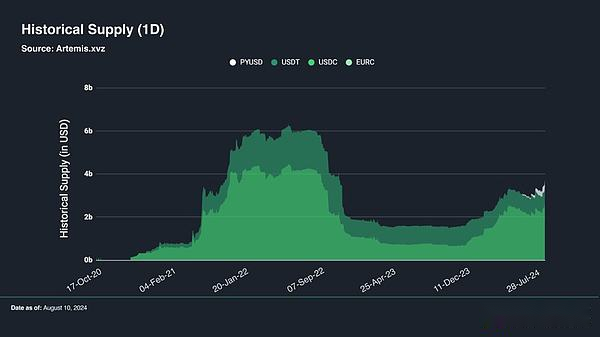
Another positive sign in Solana’s financial sector is the steady growth in the market value of stablecoins.The market value increased from US$1.89 billion on January 1, 2024 to US$3.8 billion on August 10, 2024, with a total market value increasing by approximately US$1.91 billion.
While Solana is leading the way in retail applications, it is also beginning to show a large number of institutional adoption.For example, in late May, PayPal announced the launch of PayPal USD (PYUSD) for Solana, joining other financial institutions such as Visa, WorldPay and Stripe.
One of the main reasons Solana has gained more and more institutions in the stablecoins and real-world assets (RWA) sector is the Token Extension feature released earlier this year.This new feature enables developers to integrate various advanced features into SPL tokens, such as confidential transfers for private transactions, interest-generating capabilities of real-world assets, and permanent token delegation.These features are strategically designed by Solana Labs to meet specific needs of businesses and institutions for advanced token functionality and legal compliance.
The upgrade has paid off, with Libre Capital recently launching an institutional fund for Solana.Solana users can now access various funds directly through their mobile phones, such as Hamilton Lane’s SCOPE, Brevan Howard’s Master Fund and Blackrock ICS Money Market Fund.
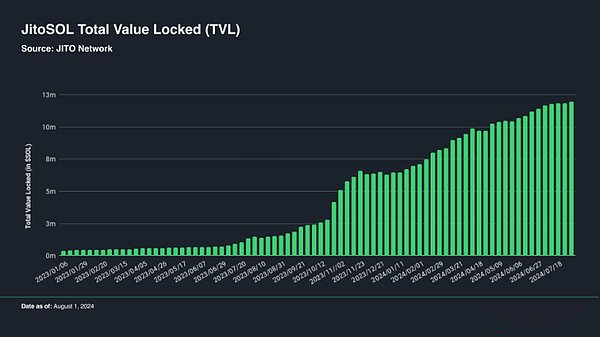
Other areas of Solana, such as liquidity staking (LST), are also growing rapidly.JITO has become the leading LST protocol, greatly increasing the number of staking of SOL.Currently, JITO has nearly 12 million pledged SOLs, with a total locked value (TVL) of more than US$1.7 billion.

The biggest success story this year may be the pump.fun of Solana Chain, which is a meme coin release platform.The project effectively grasped the huge speculative demand of meme coins by providing a platform with an improved meme coins release mechanism.Since its launch in January 2024, pump.fun has quickly risen to the top ten agreements for charges and income.Over approximately six months, the platform’s total revenue/fee has soared from about 8 SOL on February 1, 2024 to 518366 SOL on August 1, 2024.
As emphasized above, Solana is not just a meme coin chain, but a public chain that flourishes in many aspects of the financial field.It successfully captured the speculative demands of retail investors in the market, while also steadily gaining institutional-level adoption from enterprises and institutions.
Here is a brief introduction to important developments in Solana’s financial sector and some interesting projects.
(1) Compute Labs and DBunker
Compute Labs and Dbunker are opening a new territory at the intersection of real-world assets (RWA) tokenization and decentralized physical infrastructure networks (DePINFi).Their goal is to lower the barriers to access AI computing and DePIN by reducing the high initial capital costs, the need for expertise, and the complexity of managing physical infrastructure.
Compute Labs achieves this through its Compute Tokenization protocol (CTP) converts GPUs to GNFT (GPU non-fungible tokens).The protocol effectively financializes computing hardware, which can then be deployed in various DeFi activities, unlocking new value and unlocking the GPU market as a class of assets.
DBunker tokenize physical mining hardware through its platform, thus simplifying DePIN, creating digital assets representing physical mining equipment shares, allowing users to participate in DePIN without the complexity of managing the physical infrastructure.
(2) PARCL
Parcl is a decentralized real estate exchange developed based on Solana, allowing users to trade and speculate on prices in the global real estate market.This can be achieved through Parcl’s City Index, which tracks the median price per square foot or per square meter in each city, providing users with information on the entire city’s real estate market, not just individual property information.
(3) PYUSD
PayPal USD (PYUSD) is PayPal’s stablecoin.PayPal announced a strategic decision to integrate with Solana, calling it a “next phase of adoption” that aims to leverage Solana’s fast finality and low fees to kickstart the next era of digital payments.
(4) Drift
Drift is a decentralized exchange (DEX) on Solana, focusing on improving order processing speed and market efficiency.The Drift protocol supports a variety of features such as spot trading, perpetual contract trading, borrowing and lending, and passive liquidity supply.The Drift protocol is constantly expanding its product range and recently announced it will release a forecast market.
(5) Jupiter
Jupiter is the leading DEX aggregation platform on Solana, providing the best and cheapest paths to trade on Solana.The platform offers a range of products such as limit orders, perpetual contract trading, DCA (average US dollar cost), fiat deposits and bridging capabilities.Jupiter also has the “LFG Release Platform”, which helps release protocols such as Sanctum, Zeus and SharkyFi. In addition, deBridge Finance will be released at the end of August.The Jupiter team quickly adapted to the market and recently added a new product “Ape” to support a smoother and safer meme currency trading experience.
(6) JITO
JITO is a liquid staking (LST) protocol that integrates the maximum extractable value (MEV) into its staking mechanism to share the benefits with holders.In 2024, JITO’s market share in the LST sector has grown rapidly and is now the largest liquidity staking (LST) protocol in the Solana ecosystem, with TVL exceeding $11 million.
(7) Solayer
Solayer is the top market on Solana.Solayer adopts a different restaking approach, rather than focusing on ensuring off-chain bridging, oracle and rollup security, it focuses on providing higher transaction priorities and the possibility of guaranteeing block space for on-chain dApps.The Solana restake agreement recently received investment from Binance Labs and has completed a Builder Round financing with well-known figures in the Solana community such as Anatoly Yakovenko, co-founder of Solana Labs.
(8) CUBE
Cube is a leading hybrid decentralized exchange (HEX) that combines sub-chain order matching with on-chain settlement by utilizing multi-party computing (MPC) technology to provide an efficient, secure and compliant trading experience.
(9) Magic Eden
Magic Eden is the main NFT market on Solana, supports multi-chain environments including Ethereum, Polygon and Bitcoin Ordinal, providing a publishing platform for various projects or BTC inscriptions.
(10) Tensor
Tensor is a customized platform for professional NFT traders on Solana, integrating AMM and market capabilities.Users can access real-time data, NFT’s candlestick pricing AMM, and adopt various trading strategies, including large-scale acquisitions, bidding, NFT listing/delisting.In addition to these features, Tensor also provides retail users with various reward plans to launch a battle for the king of the NFT market with Magic Eden.
4. Decentralized Physical Infrastructure Network (DePIN)

Decentralized Physical Infrastructure Network (DePIN) utilizes various incentive mechanisms to crowdsource, operate and maintain real-world physical infrastructure on blockchain networks.The decisive feature of DePIN is the aggregation of necessary infrastructures, such as physical hardware or software.
However, at a more fundamental level, the most important aspect of the DePIN business model is the ability to effectively manage and utilize data transmitted through the network’s physical or digital infrastructure.For example, Helium supports wireless connectivity by transferring data from IoT devices.IO.NET uses its GPU/CPU node network to optimize data processing of machine learning tasks.Hivemapper collects and uses geospatial data through dash cams to provide map services.Therefore, DePIN is basically data-driven, requiring a reliable base layer with high transaction throughput, high composability, and high scalability.
With its ability to expand thousands of transactions per second (TPS), low latency, high cost efficiency, and a thriving ecosystem and developer community, Solana has become the leading public chain in the DePIN field.These advantages make Solana the preferred base for leading DePIN projects such as Render Network, Hivemapper and Helium.Solana’s DePIN field is booming, with related projects achieving significant growth and practical application.A typical example is Helium, whose mobile user base more than doubled in 2024 and exceeded 100,000 in July this year.
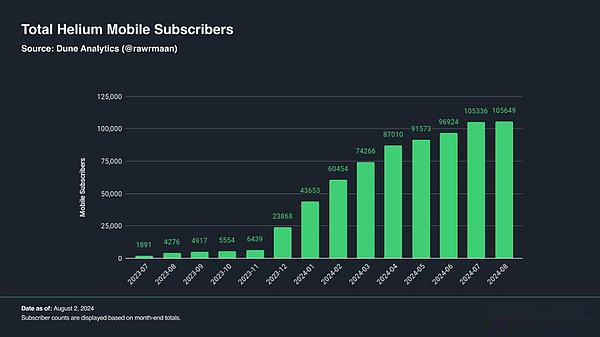
The strong growth of Solana DePIN has attracted and will continue to attract many new (and innovative) DePIN projects to join the Solana ecosystem, such as Grass, Exabits and Natix.This trend may continue because Solana’s simple and straightforward monomer approach and ability to support a variety of resource-intensive networks make it the preferred and DePIN center for cryptocurrencies.
Here is an overview of the important progress and milestones made in the Solana DePIN field.
(1) Hivemapper
Hivemapper is a global map network that uses vehicle dashcams to collect real-time, high-resolution road images and rewards contributors with its native HONEY tokens.Hivemapper was exceptionally outstanding in the second quarter, achieving several milestone achievements, such as successfully mapping 25% of the world’s road network and drawing about 28 million kilometers of street images per month.In addition, they have signed cooperation agreements with a Fortune 50 company, two top 10 online map providers in the world, and several local municipalities and property management companies.Hivemapper also shipped 5,605 dash recorders in the second quarter and plans to conduct field testing of its next generation dash recorder “Bee” soon.
(2) NATIX
NATIX is a DePIN protocol for geospatial data mapping, aiming to solve the problems of data access isolation and high business costs caused by data monopoly of large technology companies.Natix has created a global decentralized dynamic map (DDMap) by integrating proprietary artificial intelligence, edge computing and economic incentives into global crowdsourcing cameras.
(3) Ambient Network
Ambient Network is a decentralized environmental monitoring infrastructure network designed to collect global environmental data to protect the health of our planet and our residents.Ambient has developed a mobile app called AmbiGO to monitor data such as city air quality, noise levels and cleanliness by rewarding users who contribute and map environmental data.Ambient plans to enable TGE (token generation event) on Solana in the third quarter of 2024.
(4) Shaga
Shaga is a two-time global DePIN hacker pine champion and is currently developing a P2P cloud gaming platform.By connecting global gaming PCs to an open, decentralized network powered by players, Shaga hopes to improve latency and reduce reliance on large companies.
(5) 375ai
375ai is a DePIN that builds advanced decentralized wireless edge infrastructure.375ai launched its first product, 375edge, a sensor and edge AI node that is capable of collecting, processing and transmitting multimodal data such as environmental and traffic data.Network participants can collect and report high-quality data by deploying 375edge to receive token rewards.
(6) DAWN
DAWN (Decentralized Autonomous Wireless Network) is a Solana DePIN protocol developed by Andrena.DAWN is a user-driven decentralized wireless network that provides affordable gigabit speed home and commercial internet.
(7) Helium
Helium is a safe and cost-effective 5G wireless connection DePIN.The Helium network is powered by a global community of distributed hotspot operators that provide wireless network coverage and receive Helium tokens in return.Helium offers highly competitive mobile phone packages in U.S. states for just $20 a month.
The DePIN flywheel works well for Helium, as their Helium mobile subscriptions exceeded 100,000 in July 2024, more than doubled from the beginning of the year.Helium also announced a Helium licensing program.The program will enable third parties to produce and sell Helium hotspot equipment, thereby generating revenue (license fees) and expanding the Helium network.
(8) GenesysGO
ShdwDrive, developed by GenesysGo, is a decentralized cloud storage platform on the Solana network.It uses directed acyclic graph (DAG) data structures to achieve efficient decentralized data storage, management and computing.
At the Solana Crossroads conference in Istanbul, GenesysGO launched its first decentralized storage network powered by mobile devices only.Mobile shdwDrive will be integrated into Solana Mobile Chapter 2, with more than 150,000 bookings.The integration will allow Solana Saga users to turn their devices into decentralized storage nodes and receive SHDW (Native Tokens for GenesysGO).
(9) StarPower
StarPower is a decentralized energy network (DEN) protocol on Solana. It builds a distributed energy network by aggregating and utilizing the energy of various distributed energy devices (DERs) to form a unified and powerful distributed energy network that can meet the needs ofThe growing demand for energy in artificial intelligence.StarPower has released its first product, StarPlug, which will be used to build its global energy network.
5. Artificial Intelligence
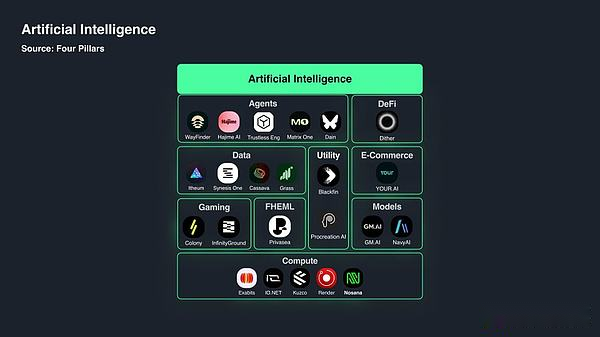
The rapid development of artificial intelligence (AI) in the past few years has had a significant impact on various industries and has sparked wide public interest in the applications of generative artificial intelligence such as ChatGPT.However, most of the development, both at the infrastructure and model levels, is dominated by closed-source Web2 companies.This centralized pattern has spawned the idea of developing open source alternatives within the crypto industry, so last year, the number of new AI projects surged.

The popularity of decentralized AI has greatly benefited Solana, because many DePIN x AI projects have chosen to be released on the Solana network.This is largely due to Solana’s technology stack, which provides a significant advantage over competitive chains.The parallel execution capability of Solana smart contracts has significantly improved the transaction processing efficiency on the Solana chain by allowing multiple non-conflict transactions to be executed simultaneously, effectively optimizing computing hardware such as GPU and CPU.This is very beneficial for projects that perform large amounts of data and computing processes, as Solana allows them to coordinate resource allocation and process transactions on a large scale, enabling faster and more efficient operations.
However, although Solana’s field of artificial intelligence has not yet matured like DePIN, it is in a promising stage with three particularly promising areas: decentralized computing networks, data and AI agents.
Next is a summary of important developments in the field of Solana’s artificial intelligence, as well as projects worth paying attention to that may affect Solana’s future development.
(1) IO.NET
IO.NET is a decentralized GPU aggregation platform that provides consumer-level and enterprise-level computing solutions for AI/ML.It stands out as one of the largest decentralized computing networks, leveraging idle GPUs around the world to provide cost-effective and scalable solutions for a variety of AI/ML tasks, including parallel training, hyperparameter tuning and inference workloads.
IO.NET experienced a turbulent second quarter ahead of its token release, with issues related to the number of GPUs displayed in web browsers.The IO.NET team prevents GPU vulnerabilities and ensures greater transparency by implementing a Proof of Work (PoW) verification system.The team has shown great determination to continue to promote new collaborations and updates.
(2) Kuzco
Kuzco is a decentralized GPU cluster created based on Solana that provides scalable and cost-effective inference for large language models (LLMs).Kuzco’s network requests are growing, new nodes are constantly entering the network, and it is currently used for LLM inference work for DecentAI developed by Catena.
(3) Render Network
Render Network is a GPU network focused on providing artists and businesses with scalable and cost-effective 3D rendering solutions, with continuous success through its application OctaneX.The integration of the Render-powered OctaneX in Apple’s latest iPad Pro was presented in Apple’s keynote and produced an opening shot for the HBO TV series The Last Survivor.
(4) Exabits
Exabits, Incubated by Harvard Innovation Lab, is developing the “Basic Layer of AI Computing” for AI training, reasoning and fine-tuning.
(5) Grass
Grass is a DePIN that aims to democratize AI model training through a distributed network consisting of incentive nodes that share unused bandwidth to collect and process web data.Grass achieved many achievements in the second quarter.First, they successfully opened sourced the user dataset, which contained 600 million Reddit posts and HuggingFace comments, which can now be publicly used for open source AI training.In addition, Grass desktop nodes can now achieve higher efficiency.Grass has announced the integration of Solana wallet addresses with the user’s Grass account, which will be used to distribute rewards to nodes when the node’s data is used for artificial intelligence inference or training workloads.
(6) Synesis One
Synesis One is a decentralized Train2Earn platform that anyone can monetize by training AI.Data is the cornerstone of artificial intelligence and requires tagging and annotation to improve the quality and accuracy of the underlying model.However, in the current state, microtasks and providing raw data are either extremely low-paid or performed by tech companies without the user’s consent or knowledge.Synesis One democratizes AI training by incentivizing data crowdsourcing, where participants actively provide raw data and perform micro-tasks such as data tagging/annotation, or passively provide data by holding “Kanon NFT” to receive rewards.
(7) Privasea
Privasea uses Full Homomorphic Encryption (FHE) to provide security and data privacy solutions for AI and DePIN.As artificial intelligence becomes a part of everyday life, sensitive data such as financial information, medical records and personal identity details are increasingly susceptible to being leaked or manipulated, putting our digital identity and privacy at huge risks.
Privatsea uses various FHEs to encrypt and protect sensitive data.It also developed a dApp called “ImHuman” that allows users to save and encrypt their biometric data locally as NFTs, proving that they are real people, and preventing robots and malicious artificial intelligence impersonations.
(8) Dain Protocol
Dain Protocol is a decentralized artificial intelligence network composed of autonomous agents that can communicate, interact, learn and collaborate.Dain aims to solve problems related to today’s Internet fragmentation by leveraging the collective intelligence of multi-agent systems to provide a unified platform to deploy and use AI agents with multi-module capabilities.DAIN recently released their codeless DeFi AI agent, DainTrader, for alpha users.
(9) Matrix One
Matrix One is committed to creating multi-module AI agents by providing the necessary interfaces and tools that can be monetized and integrated in the virtual and real worlds, making it easy for anyone to create personalized AI characters.The protocol was created to improve the problems of high technical barriers, poor profit distribution, lack of selectivity and AI role ownership of existing AI role platforms.Matrix One makes it easier to create, own and trade tokenized AI roles by providing developers and creators with a suite of infrastructure tools such as character studios, 3D character visualizers, model indexes, and markets, thusMinimize these problems.
(10) WayFinder AI
WayFinder AI is a decentralized protocol that allows users to navigate and operate between on-chain applications and ecosystems.WayFinder powers Parallel Studios’ new game Colony, a platform with AI agents with various features, such as smart contract creation.These agents can be highly customized with their advanced memory capabilities.
6. Consumer Applications

With some bankruptcy and turbulent events happening, many people are unsure what the future of the crypto world will look like after the crypto industry is in trouble in 2022.Naturally, crises often have vicious effects, forcing the industry to turn pragmatism, and the mainnets began to discuss the measures to obtain real adoption.
Solana’s developer-friendly technology stack is optimized for user experience and is ready to become a public chain for mass adoption, the most consistent network to achieve these goals.As a result, the network has seen strong growth in a variety of consumer-facing applications, such as gaming and mobile trading dApps.
Next comes a short list of consumer applications that demonstrate Solana’s user-centric approach.
(1) Echelon Prime
Echelon Prime provides basic support for Parallel TCG (a science fiction exchange card game) and Parallel Colony (a strategy survival game that integrates AI characters).
(2) STEPN
Stepnoofficial is a social lifestyle app on Solana that connects people around the world, encouraging a positive and healthy lifestyle through STEPN’s digital NFT sneakers, where users can receive rewards when performing various daily activities.
(3) Audius
Audius is a decentralized music sharing platform that bridges fans and artists, providing users with exclusive new music while allowing artists and creators to maintain control over their work and receive fair rewards.Audius has licensing agreements with all major performance rights organizations in the United States (PROs) including ASCAP, BMI, GMR and SESAC.
(4) MetaDAO
MetaDAO is a decision-making market platform on Solana, which uses the concept of “futarchy” to strengthen governance mechanisms.MetaDAO allows users to participate in governance decisions by trading tokens representing different potential outcomes.
(5) CUDIS
CUDIS is an artificial intelligence health ring that helps users manage and track their health by monitoring and providing insights into various health metrics such as sleep, steps and daily activities.CUDIS provides users with personalized health advice through an integrated biometric dashboard, artificial intelligence coaching and a point reward system for users to achieve their goals, thereby helping users achieve their health goals.CUDIS successfully completed the first round of ring sales, and the second round of sales is now in progress.
(6) DeStreet
DeStreetdApp is a social trading app that finished second in the DAO and community competitions of Solana Renaissance Hackathon and first in the Bonkathon competition.dApp allows traders to create, discover and share transactions on social media by simply sharing links.Transaction initiators can earn 20% of the total profit, and users can subscribe to their favorite internet celebrities to automatically follow their transactions, adding elements of gamification and social prestige.
(7) DFlow
DFlow is a Solana-based non-custodial mobile trading platform focusing on accelerating on-chain trading adoption from the application and infrastructure side through their mobile trading applications and liquidity aggregators.The DFlow mobile app has just been launched recently and is now available for download on iOS and Android.
(8) Follows.App
Follows.App is a social trading platform on Solana that innovates creator economy through creator-Fi.The app allows fans (users) to support and invest in the influencers they like by buying and selling Follows (following), providing fans with a unique experience and providing creators with new profit opportunities.
7. Community and Culture
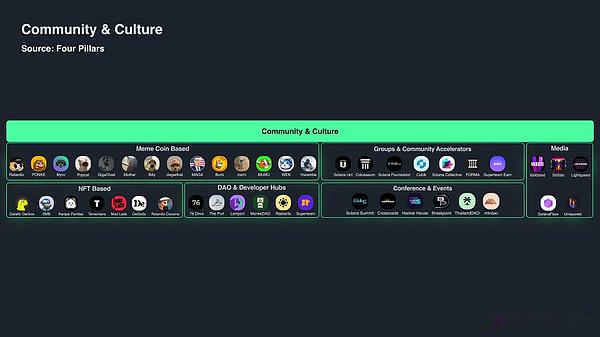
FC Barcelona’s La Masia youth training camp is known for developing world-class players such as Messi, Xavi, Iniesta, etc. They not only won the championship for themselves, but also for the entire club.It brought in millions of dollars in revenue, including tickets and fan equipment revenue.Like football boot camps, the blockchain community is crucial to cultivating grassroots talents, building a common culture, driving growth and success.
Solana is reminiscent of La Macia, which has built one of the most dynamic communities in the cryptocurrency space, full of passionate maximists, founders, developers and investors who are working through various initiatives, hackersThe Songhe Funding Program cultivates and attracts global talent to the Solana ecosystem.
Many of the large projects in the Solana ecosystem, such as Magic Eden, JITO, and IO.NET, started with Solana’s hackathon.Grassroots projects like this have always been loyal to Solana and are now rewarding by attracting new users, partners and network mobility, and sponsoring Hackathons to help grow the Solana ecosystem.In this sense, the Solana community is the cornerstone of a virtuous cycle, where repeated investment and collaboration allow further innovation and growth to be permanently maintained.
Culture is the adhesive that unites the community.For Solana, this is reflected in the sentence “Only possible on Solana” (OPOS), and also in the huge group formed around NFT and meme coins.
Solana NFT and meme projects, such as Solana Monkey Business (SMB), Mad Lads, Bonk, PONKE, etc., were originally purely artistic or meme expressions, but through their cultural and aesthetic appeal, they formed like-minded people.The larger community is formed, thus strengthening the entire Solana community.For example, Solana Monkey Business’s MonkeDAO hosted Solana’s global meet-and-finance projects, as well as Bonkathon, recently co-sponsored by Radiants, Bonk and Phase Labs, with a prize of up to $300,000 to drive innovation in the Bonk ecosystem.In this sense, Solana’s community and its cultural support are the fundamental pillars of the Solana network.
Here are some overviews of projects and communities that are shaping Solana’s culture and community.
(1) Bonk
Bonk is a dog-themed meme coin launched on the Solana chain on December 25, 2022.In 2023, Bonk airdrops were included in Solana Saga, playing an important role in its success.Since then, Bonk has developed use cases that go beyond meme appeal, such as projects like BonkBot and Bonkswap, as well as various other integrations between DeFi, gaming and NFT.
(2) dogwifhat
dogwifhat is a Shiba Inu-themed meme coin, and the picture shows the real life puppy Achi wearing a pink hat.dogwifhat was launched in November last year and became popular quickly. It is currently the largest meme coin on the Solana market.
(3) PONKE
“Degenerate Gambler with Anger Problems” Ponke is one of Solana’s most popular meme coins and has been active since the end of 2023.Despite the volatility of Ponke’s price, the community only seems to be stronger due to its huge cultural appeal and the viral TikTok memes amassing millions of views.
(4) Popcat
Popcat is an online meme derived from October 2020, showing two images of a domestic shorthair cat named “Oatmeal” in a series of videos, one with a mouth shut and the otherIt is opened with the mouth, and the second image has been edited to make the cat’s mouth look “O”-shaped.
(5) Mad Lads
The Mad Lads NFT family is built on the xNFT standard and aims to explore the potential of NFT as a decentralized application.Mad Lads’s release has injected new vitality into the troubled Solana community that has been tumbling due to the FTX collapse.
(6) Retardio
Retardio is a Solana meme coin that emerged after an online debate in which internet celebrity Andrew Tate insults the X account @trading_axe is retardio (idiot).”Since then, the word “retardio” has become famous in the crypto circle, forming a community similar to a cult around it.
(7) MonkeDAO
MonkeDAO is the DAO of the famous NFT series Solana Monkey Business (SMB), and is also Solana’s first NFT DAO.In 2021, MonkeDAO is also a small community full of passion for SMB NFT, and has now grown into a global community to invest, incubate and build the future of Web3.In late April, MonkeDAO renewed its contract with the Solana Foundation and added a Metaplex platform to support builders and creators of the Solana ecosystem.
(8) Radiants
Radiants is a community of creators, developers and artists who build public products on Solana.Radiants recently held Bonkathon in partnership with Bonk, Phase Labs and Solana Foundation.
(9) Superteam
Superteam is a global community of founders, developers, funders and other stakeholders who collaborate on growing and incubating new innovative projects in the Solana ecosystem.
Superteam is a truly international company with branches in 12 countries including Brazil, Germany, India, Mexico, Nigeria, Turkey, Vietnam, the United Kingdom, the United Arab Emirates, the Philippines, Malaysia and Canada to cultivate global talents.
(10) Colosseum
Colosseum is the accelerator platform for the Solana Foundation, which hosts hackathon competitions and provides key support for early-stage startups in the Solana ecosystem.Hackson winners can enter the Colosseum program, where they can get help with product launches, opportunities to connect with top venture capital firms, plus a $250,000 grant.
Colosseum hosted the Solana Renaissance Hacking Matsui, with more than 8,300 participants from more than 95 countries submitting 1,070 projects covering infrastructure, gaming, DePIN, DAO, DeFi and consumer applications.
(11) Solana Foundation
Solana Foundation is a nonprofit organization that provides grants, financing and resources to developers, projects and various programs to develop and nurture the Solana ecosystem.
(12) Breakpoint
Breakpoint is an event organized by the Solana Foundation, which brings together industry experts, artists, developers and community members.Breakpoint lasts for several days and has a variety of fascinating speeches and seminars.This year, Solana Breakpoint will be held in Singapore on September 20 and 21.
(13) Crossroads
Crossroads is an annual community conference held in Istanbul, Türkiye.Solana Crossroads was created to connect members of Solana’s global community, and the conference offers opportunities to communicate, speak and learn about the latest developments in the Solana ecosystem.More than 3,000 people attended this year’s Crossroads Conference and more than 50 people gave speeches.
(14) Solana Summit
The Solana Summit is the largest gathering of Solana founders, creators and developers in the Asia-Pacific region (APAC).It aims to build connections and strengthen the Solana supporter community.The Solana Summit was held from June 20 to June 22 this year, with more than 750 attendees and more than 95 speakers and seminar hosts from 55 countries.
(15) SolanaFloor
Powered by Step Finance, SolanaFloor is the leading Solana news and media center covering the latest developments and news in the Solana ecosystem.
(16) Validated
Validated is a top Solana podcast hosted by Austin Federa, Director of Strategy and Communications at the Solana Foundation.Validated presents a fascinating, thought-provoking conversation between Austin Federa and the guests who are rethinking the internet.You can listen to the podcast on Spotify, Apple Podcast, and YouTube.


